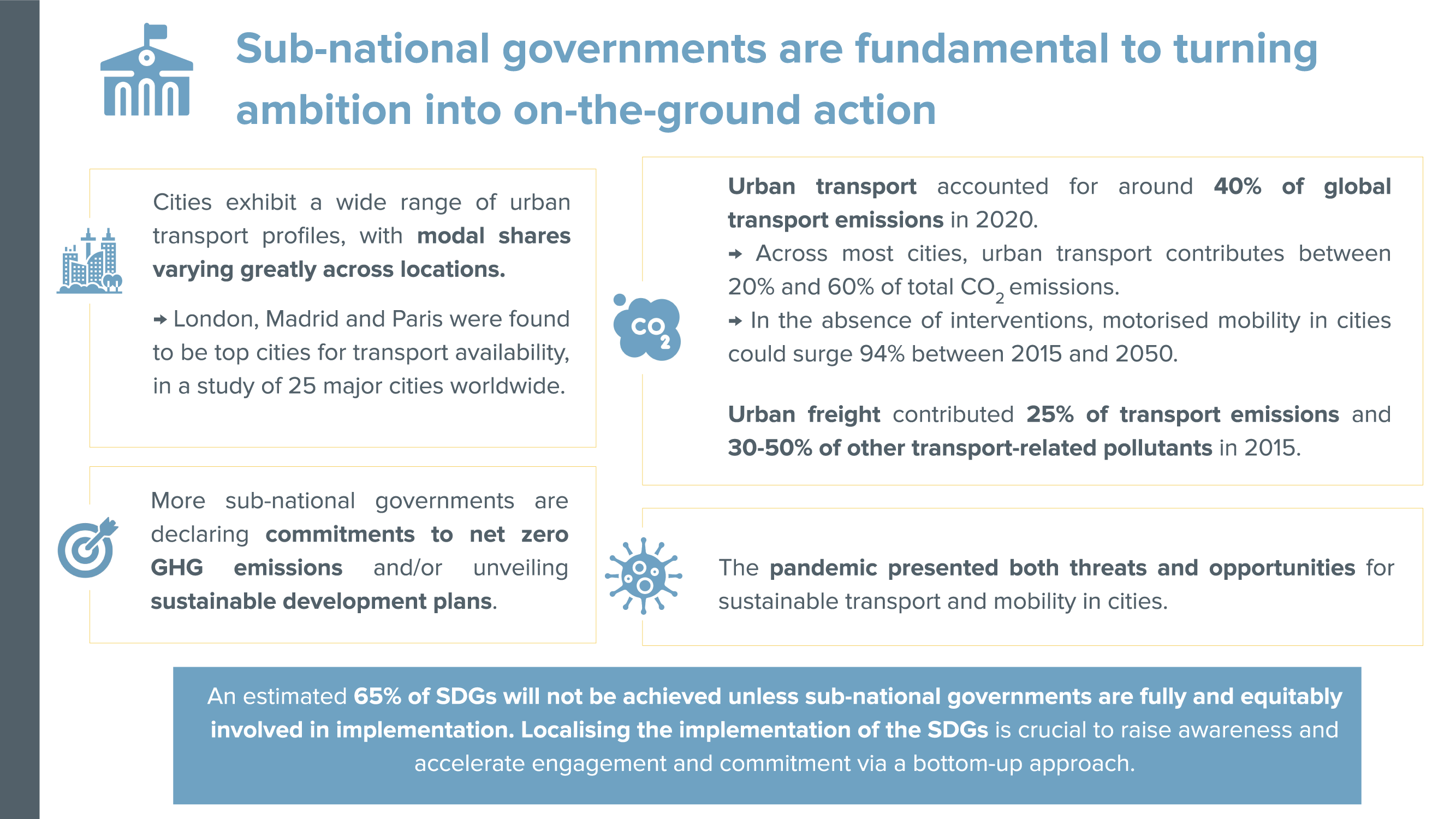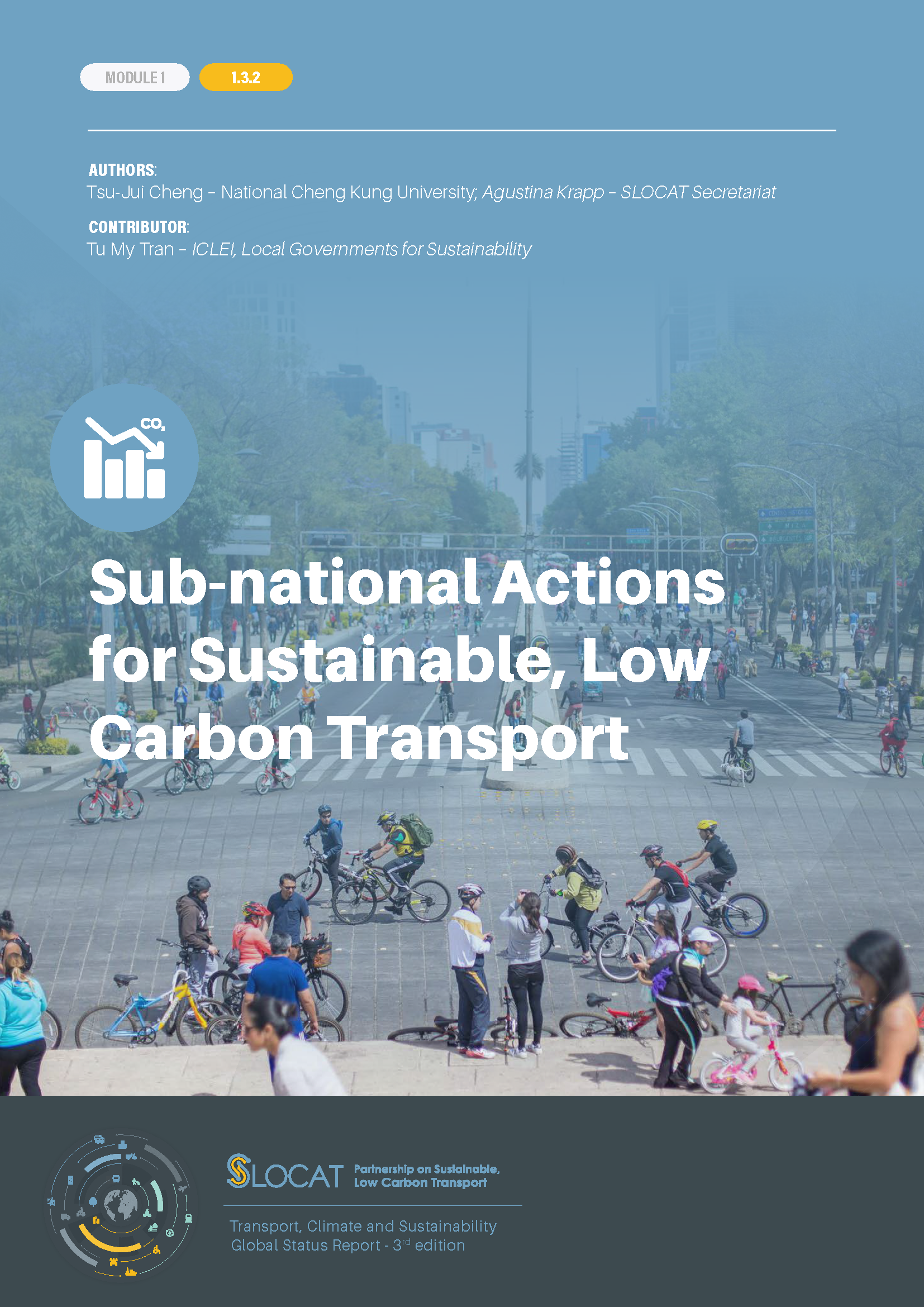-
Subnational Actions for Sustainable, Low Carbon Transport
- Key Findings
Demand trends
- Cities exhibit a wide range of urban transport profiles, with modal shares varying greatly across locations.
- A 2021 study on 25 major cities worldwide found that London (UK), Madrid (Spain) and Paris (France) were the top cities for transport availability – boasting extensive railway connections, well-developed road networks, and ample cycling lanes and pedestrian infrastructure.
- The COVID-19 pandemic presented both threats and opportunities for sustainable transport and mobility in cities.
Emission trends
- Urban transport accounted for 8% of global carbon dioxide (CO2) emissions and around 40% of global transport emissions in 2020. In the absence of interventions, motorised mobility in cities could surge 94% between 2015 and 2050.
- Transport emissions in cities rebounded after pandemic-related mobility restrictions were removed.
- Urban passenger transport remains the largest source of CO2 emissions and pollutants in the transport sector, although these emissions vary widely by city and region. Across most cities, urban transport contributes between 20% and 60% of the total CO2 emissions.
- Cities in Europe, North America and Oceania had the highest per capita greenhouse gas emissions from 1960 to 2012, ranging between 10 and 25 tonnes of CO2 equivalent, two to five times the levels in Asian and African cities.
- Urban freight transport contributed 25% of transport-related CO2 emissions and accounted for 30-50% of other transport-related pollutants in 2015.
Policy developments
- To tackle urban emissions, more sub-national governments are declaring commitments to net zero greenhouse gas emissions and/or unveiling sustainable development plans.
-
As of April 2023, 1,148 cities were participating in the Race To Zero campaign, launched in 2020 to drive net zero commitments prior to the 2021 United Nations (UN) Climate Change Conference in Glasgow, United Kingdom (COP 26). Around 80% of sub-national governments that had joined the campaign had yet to set a net zero target as of 2023. Less than 1% of cities and 4% of regions had implemented legally binding targets, and around 9% of cities and regions had included net zero targets in their policy documents. However, there is a disparity among sub-national governments in their commitments to net zero targets.
- An estimated 65% of the UN Sustainable Development Goals (SDGs) will not be achieved unless sub-national governments are fully and equitably involved in implementation. Localising implementation of the SDGs is crucial to raise awareness and to accelerate engagement and commitment via a bottom-up approach.
- Transport is a central element reported in the 153 Voluntary Local Reviews (VLRs) submitted by sub-national governments between 2021 and April 2023; however, specific transport targets are not commonly mentioned.
- Several cities have reported in their VLRs comprehensive transport strategies that encompass mobility and transport planning. Across these VLRs, all cities emphasise the importance of public transport and active mobility in achieving climate action, equity, safety and resilience.
- When comparing the sub-national net zero targets with the VLRs, it becomes apparent that the complex and fragmented nature of the transport sector, with its multi-level delivery structure, poses challenges in establishing measurable targets.
- Alignment between national net zero targets (such as those included in Nationally Determined Contributions under the Paris Agreement) and sub-national net zero commitments, as well as VLRs, is currently not evident.
- The use of sustainable urban mobility plans (SUMPs), initially introduced in Europe, has since expanded to cities in various regions worldwide.
- Sub-national transport policies and investments have placed increased focus on active mobility and public transport, serving as “pull” or “carrot” approaches to encourage the adoption of zero- and low-emission transport modes.
- A growing number of cities have made available free or affordable public transport locally as a means to alleviate national economic crises (such as inflation) and to shift trips from private vehicles to public transport.
- Sub-national policy makers, particularly in Europe, also have embraced “push” or “stick” approaches – such as parking management and congestion charging – to alleviate congestion and redistribute urban space.
- Many urban areas have adopted and piloted access regulations, zero-emission zones and clear air zones to reduce emissions and improve air quality. A number of cities have established specific zero-emission zones for freight transport (ZEZ-Fs), ranging from urban delivery vans to medium- and heavy-duty trucks.
- There is growing momentum for sub-national governments to electrify bus fleets as a way to enhance the energy efficiency of public transport and car-sharing fleets.
Authors: Tsu-Jui Cheng, National Cheng Kung University; Agustina Krapp, SLOCAT Secretariat
Contributor: Tu My Tran, ICLEI – Local Governments for Sustainability


